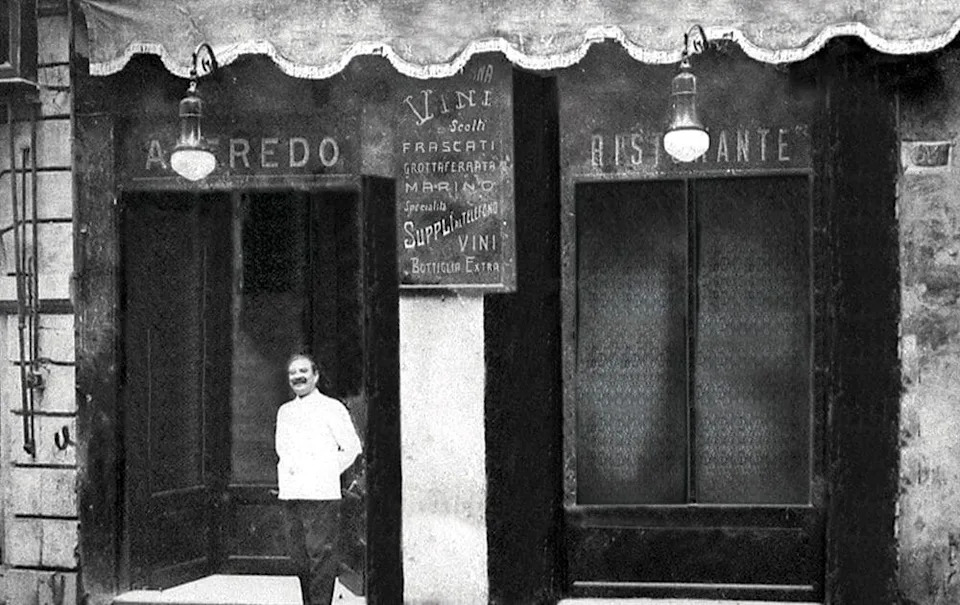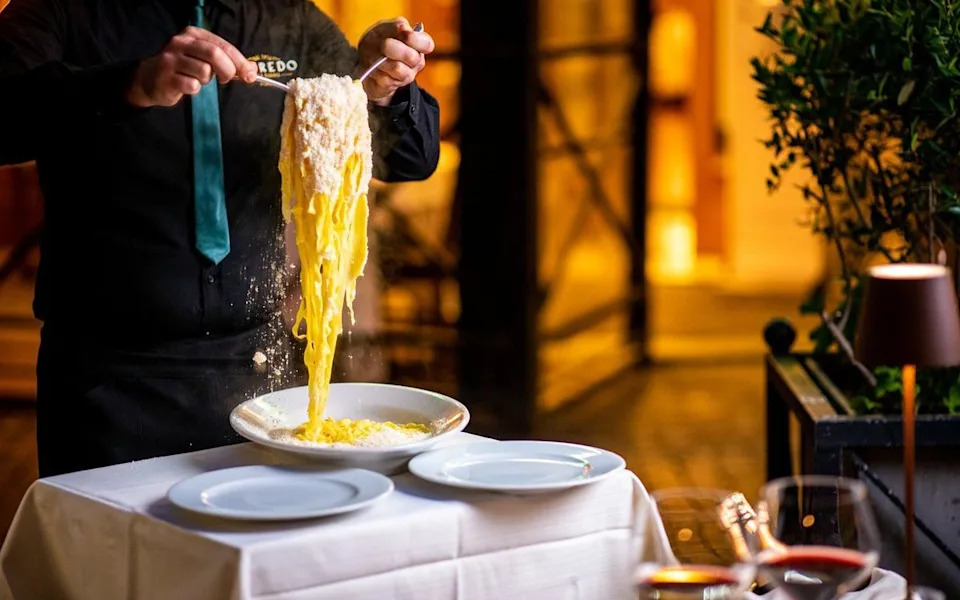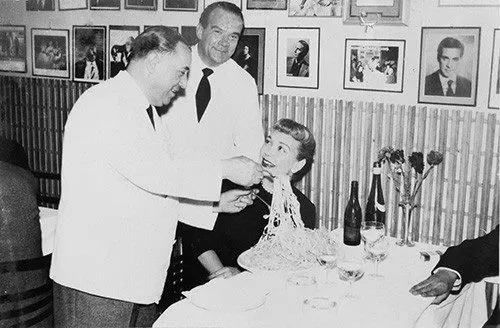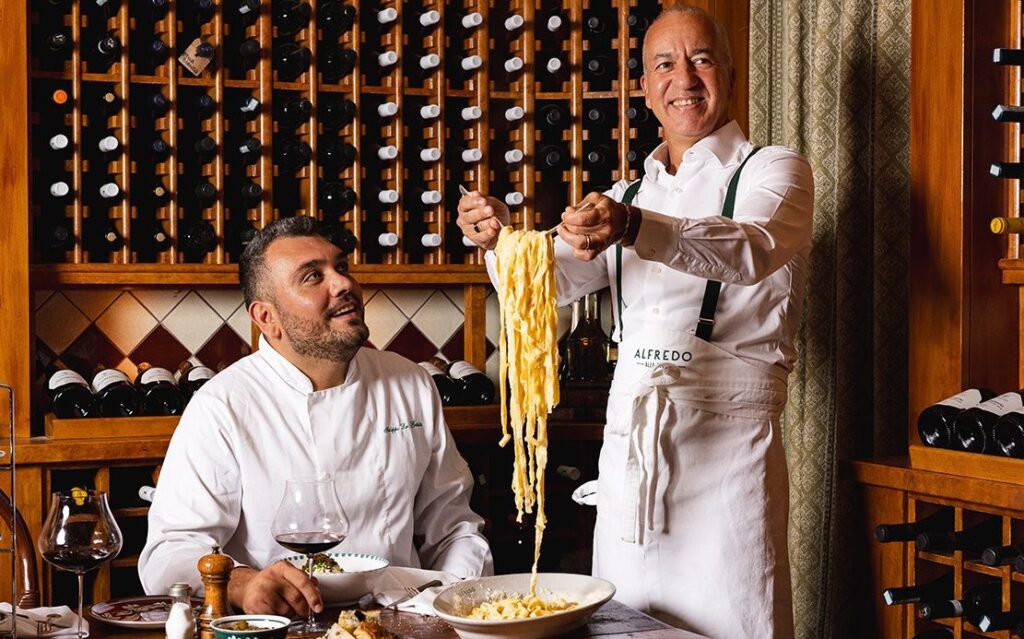Like many great Italian dishes, fettuccine Alfredo started with a new mother in need of sustenance and cheering up. Alfredo Di Lelio, a young Roman chef, created the dish in the early 1900s in a bid to entice his wife Ines, convalescent at the time, to eat after the birth of their first child.
Or so the story goes. That’s the thing about Italian food: the tale is often longer than the sheet of pasta. Still, there must be some truth to it – much the same as the story behind minestrone (a recipe for postpartum women) and tiramisu (long claimed by a late restaurateur from Treviso, but really invented by his wife, tired from a growing family) – because it’s been countlessly regaled by wistful diners at Alfredo alla Scrofa, the restaurant Di Lelio founded in Rome.

Alfredo Di Lelio, pictured here outside his restaurant, created fettuccine Alfredo in the early 1900s – Alfredo alla Scrofa
There will be readers who believe fettuccine Alfredo to be an American dish. In cities such as New York, where Italian cuisine has morphed into something else entirely, it is served with a sauce plumped up by cream – nothing short of blasphemous in Italy. Chicken, another crime, is commonly added; bacon too. Then comes chopped parsley, possibly a sprinkle of chilli.
“It is s—t”, says Mario Mozzetti, the current custodian and owner of Alfredo alla Scrofa, his family having bought the place from Di Lelio in the 1940s.
Mozzetti has flown in from the Italian capital to cook at Gloria in Shoreditch, bringing with him the original recipe for the famous dish – a triptych of ingredients: freshly made fettuccine, butter and parmesan – which he says is too regularly misunderstood and debauched.
“These people, they cancel the pasta. Some of them want to destroy it and change tradition and I get upset about it. New ideas and innovation are fine but you must remember the past. If you change the dish, it isn’t fettuccine Alfredo any more, it becomes something else.”
Mozzetti takes his stewardship seriously and he’s pushing for a keener global knowledge of the authentic recipe. There’s an argument to say it isn’t canonical: Rome’s predominant pastas are carbonara, cacio e pepe, gricia and amatriciana, with the first two in particular having seen a mighty renaissance in Britain over the last 10 years. Mozzetti believes Alfredo should be next in line to be trumpeted with all the fanfare of a new emperor.
“It is full of history, a beautiful story,” he tells me between sips of espresso. “Alfredo, he wanted to help his wife, who was upset. So he took the fettuccine and danced with a fork and a spoon, preparing the pasta in front of her. He moved very gracefully, one-two, one-two, to create the texture, the sauce. He had success, it cheered her up.”
That same technique is still employed today by Mozzetti, whose grandfather started as a waiter at the original restaurant in the 1920s before buying it and continuing the legacy.
Entrusted to the expert hands of Mozzetti’s grandfather, the pasta now lives on at Alfredo alla Scrofa, in a plush Roman dining room, ever-glamorous in the way that only Italy seems to manage: black and white photos of famous diners on the walls, pressed white linen tablecloths, dark wooden chairs, soft lighting and the sound of a small man playing the violin.

Guests at Alfredo alla Scrofa are treated to dinner theatre as the celebrated pasta dish is served at the table – Alfredo alla Scrofa
Mozzetti prepares fettuccine tableside with gold cutlery, impressing guests with “the dance of the montecare”. He is artful, romantic. He has insured his hands.
“Yes, it’s true. I cannot say how much,” says the restaurateur with a wry smile. “It is too much. It’s a skill, you must use the fork and spoon in a special way. It takes a long time to learn. I have started an academy to train others. Before, it was just my grandfather who prepared the pasta, my father did the same. I am more modern – my waiters spend three months learning and do the same.”
At Alfredo alla Scrofa, the dish costs €25, which is expensive for pasta in the Italian capital but also affordable by comparison to other places. The lasagne at Rao’s in New York is $36 – and that’s without the necessary American tip; in London, Carbone’s vodka rigatoni is £29.
Mozzetti explains: “The gold cutlery dates back to the early days when Hollywood stars first started coming. The first set was a gift from Douglas Fairbanks, the King of Hollywood, and Mary Pickford.
“They visited while on their honeymoon and gave Alfredo the fork and spoon as a gift with the words, “To Alfredo, the king of noodles” inscribed along the side. They told all their friends in America and whenever people went to Rome to make a film, they visited and they fell in love with fettuccine.”
The list of celebrity patrons is long. First came Hollywood: Ava Gardner, Brigette Bardot, Audrey Hepburn and Tony Curtis. Then musicians and artists like Jimi Hendrix and Salvadore Dali. Italian royalty have been, even Sophia Loren; Frank Sinatra and Marilyn Monroe were huge fans. Its light isn’t fading either: players from local football team Roma go during the off season.

Old Hollywood celebrities like Shirley MacLaine were quick to file into Alfredo alla Scrofa to try the dish – Simone Pagano/Alfredo alla Scrofa
“Unfortunately some players from Lazio too,” says Mozzetti. Other guests include Georgia Meloni, the Italian prime minister went before her rise to power. In 2024 Ed Gamble, the British comedian best known for co-creating the hit food podcast Off Menu, visited with his wife. He added gold leaf to his fettucini Alfredo (truffle and caviar are available too, embellishments allowed by Mozzetti).
Is the clientele important? “It is the story, and it’s important to be busy,” Mozzetti explains. “But local people come to eat too, it’s not just tourists.”
More vital than anything, it seems, are the ingredients and the way the pasta is folded and prepared. The butter comes from Caseificio Cavola, a northern producer in the mountains near Modena; parmesan is aged 24 months, nutty and full of flavour. These are amalgamated theatrically, spectacularly.
“The fettuccine is very thin, it is only boiled quickly, it doesn’t need long, in very salty water,” says Mozzetti. “The butter melts into the pasta and the parmesan is added at the table before it is mixed. It’s a show. You must be a “master montecare” to do it.”
What’s next for Mozzetti in his quest to educate? Given he already sells hundreds of thousands of plates of fettuccine Alfredo each year, buying 800 wheels of parmesan and endless blocks of butter to do so, is there any need to expand? He’s coy but doesn’t disavow the notion of more restaurants.
“I do want to grow, to tell the story,” he says. “We’re over 100 years old, we have a lot of distinguished guests, and maybe there could be the opportunity to expand. But not restaurants – collaborations. To show more people the dish.
“There’s a lot of technology now so that helps spread the word. The only problem is when the influencers come in with their lights to take photos. They take such a long time that the pasta is ruined by the time they eat it – you must eat pasta straight away.”
Finishing our coffee, I’m conscious we’re in Gloria, one of the Big Mamma group’s most popular destinations and one of London’s most Instagrammable restaurants, where pasta mafaldine is also served theatrically at the table from a wheel of pecorino. But it makes for the ideal location for Mozzetti to serve true fettuccine Alfredo, if only for one night, to pass it on to a new generation.
“It’s not just about fettuccine,” says Mozzetti. “It’s about pasta, about butter and about parmesan. We want to spread the word around the world. They [producers] are behind me – they support me.
“On one hand, we are lucky because chefs continue to make “Alfredo” famous. Lots of people cook it. But we must try to help them not make it horrible – no shrimps, no mushrooms, no cream or chicken. Ninety-nine per cent of people think that alfredo is with chicken. That’s why I travel.”
Broaden your horizons with award-winning British journalism. Try The Telegraph free for 1 month with unlimited access to our award-winning website, exclusive app, money-saving offers and more.


Dining and Cooking